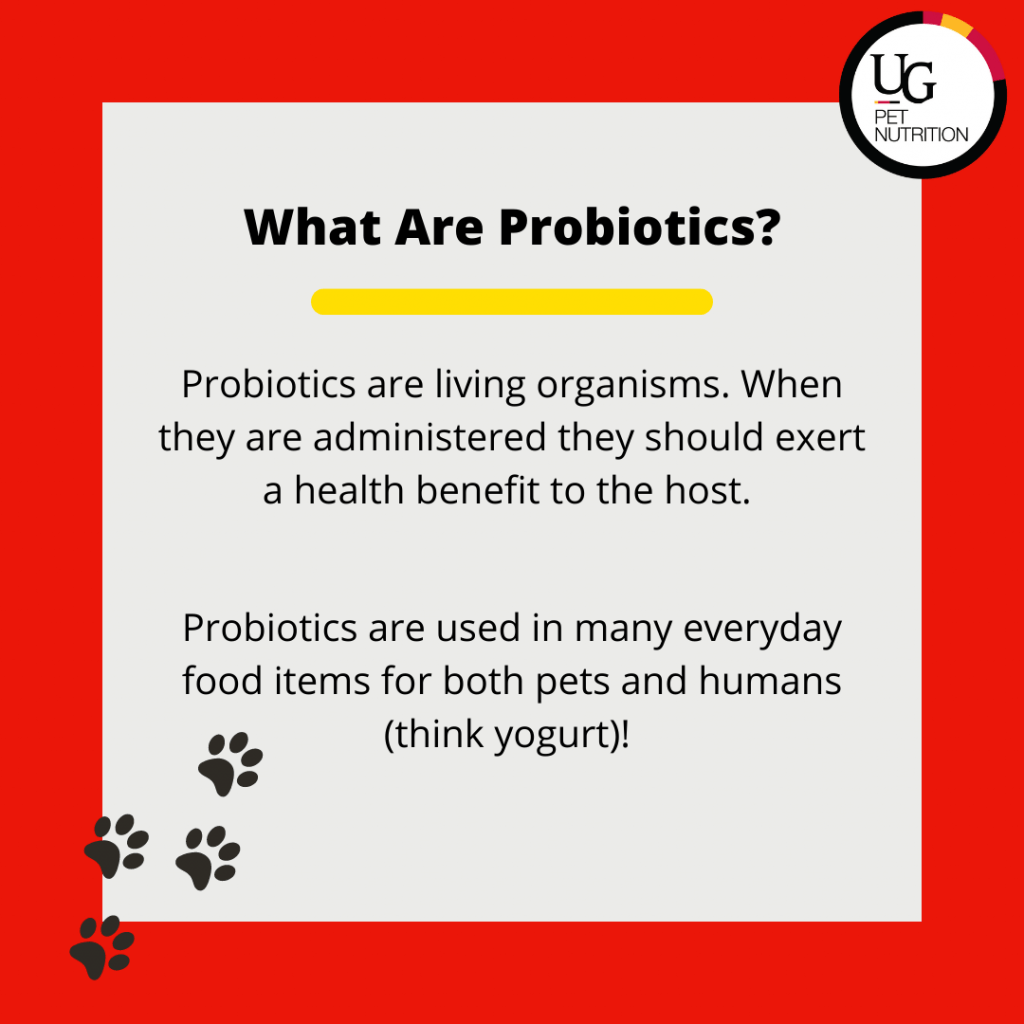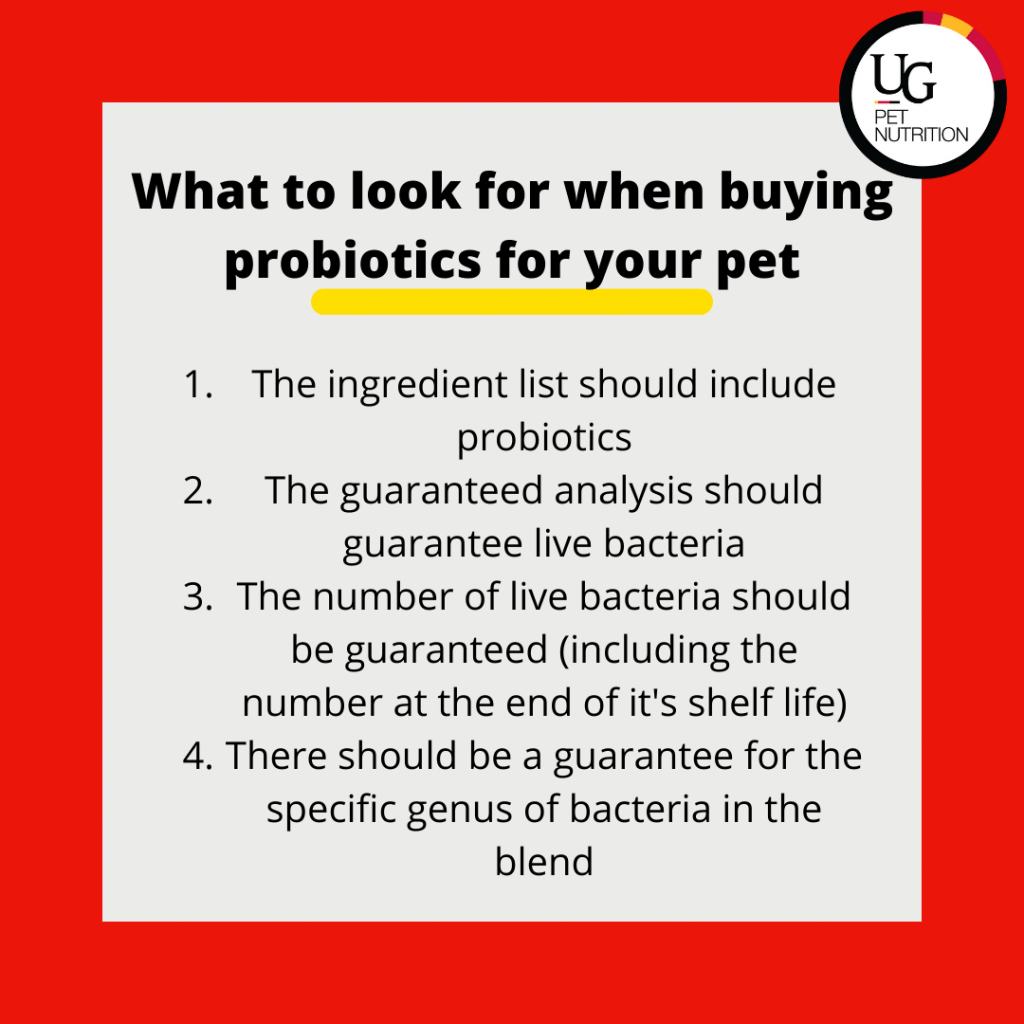Exploring Their Use in Companion Animals
The gastrointestinal tract (GIT) of animals houses a wide range of microorganisms. It has been estimated that the total number within the intestine can reach up to 100 trillion microbial cells, representing most of the host’s microbial genome (Suchodolski, 2020).
These microorganisms work together with the host and provide a mutually beneficial relationship. It provides metabolic function and regulates gut balance of the host (Suchodolski, 2020).
What are Probiotics?
Probiotics are defined as “live organisms that when administered in adequate amounts confers a health benefit on the host” (Barko et al., 2017).

How Probiotics Work in the Body
- Reduces symptoms of leaky gut
- Increases mucin which serves as a protective barrier for the gut
- Increase in defensin = help prevent pathogen infection
- Production of metabolites that give the gut energy
- Increase in antibody secretion which helps defend against infection
- Enhanced immunity to control existing microbial population and maintaining protection against pathogens or infection (Barko et al., 2017)
Probiotics are strain-specific and so how they function in the body to improve health may differ. Probiotics have commonly been marketed for their use in modulating the intestinal microbiota. However, research shows that they do not induce any major changes in the existing intestinal microbiota (Suchodolski, 2020).
Rather, they simply act to benefit the host by aiding the intestinal microbiota already present. The mechanisms in which the microbiota act remains poorly defined, particularly in clinical settings, as many studies evaluate mechanisms of action in vivo (studies done with live animals or organisms), meaning that a direct comparison cannot be made.
Probiotic Use
Probiotics are used as a dietary supplement to benefit the host, whether human, dog, cat, horses, or rabbits, to name a few. The origin of the probiotic stemmed from production animals, where it was formed on the basis to treat various diseases and disorders (Grześkowiak et al., 2015).
They are often used to support and replenish the existing microorganisms when there is a change in diet, stress, disease, or medicine use, which all disturb the microbial profile.
The three most common beneficial microorganisms in probiotics are:
- Lactobacillus
- Bifidobacterium
- Enterococcus.
Many of these probiotic supplements can be found and sold over-the-counter, just like many other dietary supplements, but many of these products don’t have what is shown on the label. Probiotics that have been proven to have clinical effects should be used since they are known to have health benefits and a specific outcome.
Before providing your pet with any supplement, including probiotics, it is important to speak with your veterinarian. Ingredients in probiotic supplements can have biological effects.
Consulting with your veterinarian on the best course of action will ensure your pet’s health and safety (Gollakner et al., 2021). Certain considerations can include:
How do you give probiotics?
- Orally: capsule, powder, chewable tablet, liquid
- Usually given with a mean
Are there side effects?
- Limited number of studies = limited information on adverse and beneficial effects
- Mostly considered safe to use
- Very little side effects
- Do not use when pets are very sick or immune compromised unless stated by your veterinarian
- Do not use if pets are allergic to probiotic ingredients (including inactive ingredients)
Will there be any drug interactions with probiotic use?
- Antibiotics and antifungals may reduce the efficacy of probiotics when given simultaneously
- Vitamins, herbal therapies, other supplements may also potentially interact with probiotics
*Please inform your veterinarian about any medication your pet is receiving
Considerations for Use
Many probiotics are used for treating diarrhea, preventing diarrhea, as well as being used as a therapy for animals effected by chronic enteropathies. It should be noted that probiotics require approximately 1 to 3 days to colonize the intestines (Suchodolski, 2020).

For immune stimulation, long-term administration is required over a period of several weeks to months (Barko et al., 2017). In dogs and cats suffering from chronic enteropathy, long-term administration is required for optimal benefits for the intestinal barrier and immunological regulation (Suchodolski, 2020).
Did you know?
Some strains of probiotics even have the ability to provide health benefits beyond the gastrointestinal tract!
Some have been shown to reduce anxious behaviour and have a calming effect on animals as well as improving the metabolism of obese animals. It has been said that this specific strain of probiotic has the ability to reduce anxious behaviours such as pacing, jumping excessive barking, and help animals cope with changes in environment or daily routine.
Probiotic Production
Not all probiotics are created equal! With probiotics, the benefits a host will experience are strain dependent. It should be noted that no probiotic is perfect!
Factors affecting efficacy of probiotic strain production:
- Different conditions between manufacturers
- Quality systems and control
- Strain maintenance
- Manufacturers must have a master lot and a working seed lot
- The master lot is the foundation in making probiotics
- The working seed lot originates from the master lot and is made into a probiotic
- Identity must be proven between production batches and deposited strains
- Quality checks are done regularly to ensure there is traceability between strains produced
- Production conditions
- Well-controlled system, genetic stability of strain, meaning that it can be reproduced repeatedly
- Manufacturers must have a master lot and a working seed lot
- Fermentation stabilization = longer shelf life
- Verify if the probiotic works: what data is provided to show this?
What about probiotic production?
How a probiotic is produced can affect its efficacy and its ability to survive in the gastrointestinal tract. In particular, the cellular components, cell structure, gene expression, functionality can all be affected by the composition of the growth medium, the phase of growth when harvested, as well as the pH of the medium.

When Buying a Probiotic:
- The ingredient list should include probiotics
- The Guarantee Analysis should guarantee live bacteria
- The number of live bacteria should be guaranteed both at the time of manufacture, and at the end of its shelf life
- There should be a guarantee for the specific genus present when it is a blend of probiotics
Disclaimer
Do not start or alter probiotic therapy for your pets until first checking with your veterinary healthcare team. Probiotics may not be appropriate for all pets. Some specific products may be inappropriate for your pet based on their individual history and needs. Your veterinary healthcare team is the best source of information on your pet’s health and nutrition.
Written by: Olivia Chiu, BScH, MSc Student (Department of Clinical Studies)
Infographics Created by: Hannah Godfrey (BSc.H. | MSc. | Ph.D. Student)
Edited by:
Dr. Adronie Verbrugghe, DVM, PhD, EBVS Specialist in Veterinary and Comparative Nutrition® (Dip ECVCN)
Hannah Godfrey (BSc.H. | MSc. | Ph.D. Student)
Shoshana Verton-Shaw, RVT, VTS (Nutrition)
References:
Suchodolski=, J. (2020, June 25). Probiotics, prebiotics, synbiotics, and intestinal health of dogs and cats. Today’s Veterinary Practice. Retrieved October 26, 2021, from https://todaysveterinarypractice.com/probiotics-prebiotics-synbiotics-dogs-cats/.
Gollakner, R., Gollakner, R., & Gollakner, C. R. (2021.). Probiotics. vca_canada_corporate. Retrieved October 26, 2021, from https://vcacanada.com/know-your-pet/probiotics.
Grześkowiak, Ł., Endo, A., Beasley, S., & Salminen, S. (2015). Microbiota and probiotics in canine and feline welfare. Anaerobe, 34, 14–23. https://doi.org/10.1016/j.anaerobe.2015.04.002
Barko, P. C., McMichael, M. A., Swanson, K. S., & Williams, D. A. (2017). The gastrointestinal microbiome: A Review. Journal of Veterinary Internal Medicine, 32(1), 9–25. https://doi.org/10.1111/jvim.14875


